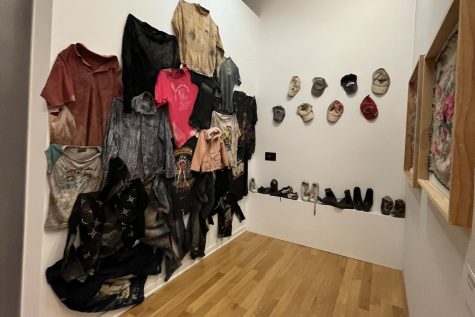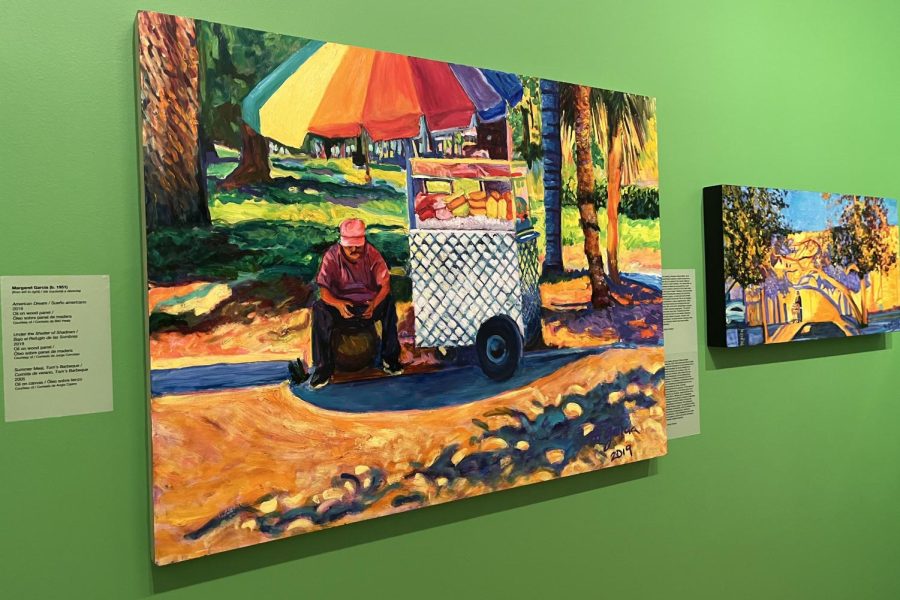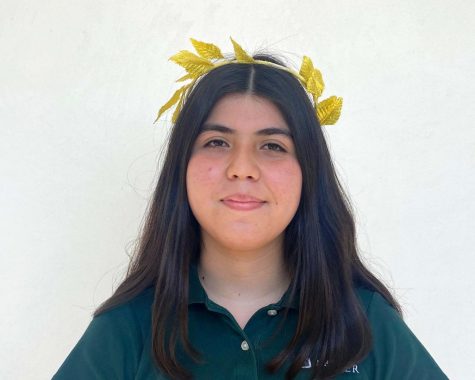Review: La Plaza de Cultura y Artes is a hidden gem
Photo credit: Lizette Gonzalez
A painting by Margaret Garcia from her collected works titled “Arte para la Gente” is displayed at La Plaza de Cultura y Arte in Los Angeles. This museum uses community geared art to evoke a powerful message of bringing awareness to the Chicano and Latino identity and history in this country.
December 15, 2022
Placita Olvera brings pieces of Mexico to Los Angeles with its traditional Dia de Los Muertos celebration, Mexican music events and street vendors in every corner. Right next to the commotion of Olvera Street, however, a small museum often goes unnoticed. The simple brick and dim architecture juxtaposes the vibrant and rich art hidden within the walls of La Plaza de Cultura y Artes.
La Plaza de Cultura y Artes honors the cultural impact of Mexicans and Mexican Americans in Los Angeles through art exhibitions and educational events. The museum is located on Olvera Street, which is the historic barrio that gave birth to Los Angeles. Its location is important to note as it demonstrates that although this museum is meant to educate others on Chicano history, it’s also meant for the community itself.
When first arriving, a coyote statue outside the building welcomes guests. The coyote is filled with handwritten resources for Latinos in Los Angeles to access: different Latin American consuls, religious support groups, law and immigration lawyers and much more. From the start, it’s obvious this museum’s goal is to convey messages of empowerment through art. The coyote serves both as a helpful resource, but also made a strong point that resources like these are hard to access by primarily Spanish-speaking Latinos.

The first exhibition is named “Arte para la Gente” by Margaret Garcia. Her paintings are extremely colorful and vivid with texture. Many depicted street vendors in Los Angeles, Boyle Height staples and portraits of members of the Chicano community. Garcia’s art is clearly community-geared.
“Being an artist is not simply about creating art but creating community,” Garcia wrote in a quote mounted on the wall. “In my community, I honor the individual through the portrait. I always leave myself room to evolve, not only as an artist but also as a human being.”
In each of her paintings, I saw my family, my community and prominent Mexican figures I rarely see in a traditional art museum. Garcia’s show is on display until June 11, 2023.
Additionally, La Plaza de Cultura y Artes did a great job in telling Chicano history. There were sections of the museum dedicated to talking about the Zoot Suit Riots and The Chicano Movement — which all happened in the backyard of L.A. — and it also delved deep into issues that made people shed tears. For example, there were videos of people who were deported from the United States. This permanent exhibition is called “L.A Starts Here!”
The multimedia aspect in this exhibit was powerful. Visitors are able to read, hear audios and watch videos to learn about how California became part of the U.S and learn directly from people who lived these experiences. It provided an intimate and emotional touch.
My favorite exhibition currently on display is called “Hostile Terrain ’94: The Undocumented Migration Project.” It is one of the most heartbreaking, yet powerful, art exhibits I’ve ever seen. It is composed of photographs, objects and a film, allowing people to live through the experience many immigrants go through when crossing the border to the United States.
The first section is photography focused on Central American immigrants — both young and elder — walking through Mexico and into the desert. The installation calls for more awareness to the danger of crossing the border. The second section is filled with walls covered by “missing” posters of people who have either died or gone missing during their journey to the U.S alongside objects art historians have found. Seeing lost clothes, backpacks and water jugs humanized the immigration journey many people embark on in search of a better life.
In this exhibit, there is a notebook that details every name of every person that has died or gone missing, and the museum updates it as news comes in. I was left speechless and saw as every visitor walked in, they, too, were equally as emotional as I. This museum allows us all to honor those stories that shouldn’t be forgotten.

Next to this section was an interactive part that allowed visitors to write their American Dream. This museum impacts every person visiting since every description is written in both English and Spanish. This choice allows people who have lived the same experiences represented in the art to be able to see themselves in these stories that are theirs too.
One of the ones I read in Spanish said: “My dreams were to help my parents build a house for them, but my dad passed away and my dream was left incomplete. Here I am not still unable to realize the American Dream.”
Through traditional paintings, historical artifacts and a cozy environment, La Plaza de Cultura y Arte created a home for community art unlike any other museum. From inside, one is able to hear the music from Placita Olvera and be immersed in the same community that this museum is representing. It is emotionally authentic.
La Plaza de Cultura y Artes enables people from all communities to learn from a new perspective on how Los Angeles came to be and the Mexican and Chicano experience in this country. Through community art, this museum is able to send a powerful message of unity, storytelling and education.
The museum is located at 501 N Main St, Los Angeles, CA 90012 and is open Wednesday through Sunday from 12:00 p.m. to 5:00 p.m. for no cost.









